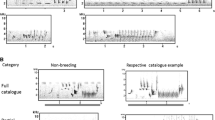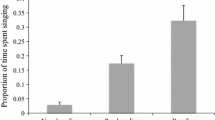Abstract
Despite the absence of pronounced changes in day length, there is considerable climatological seasonality in the tropics. Its expression can be complex like in the monsoon climate of the Indian Ocean Islands. The land mass distribution on both sides of the equator leads to seasonal changes in prevailing wind direction and seasonal patterns in food supply, which are distinct between different coasts. Here we assess that territory quality of the Seychelles warbler, endemic to the small island of Cousin peaks during the South East monsoon (April to September) in most of the island. The Southeastern wind-exposed side is exceptional by being generally poor and having slightly increased food supply in the opposite season (NW monsoon; October to March). In response, the warblers in most territories breed primarily during the SE season, while on the SE shores they tend to breed in both seasons. The result is a semi-annual periodicity in breeding. Individual pairs can breed in 6 months intervals. In the poorer territories on the SE shore most of them indeed do this, while in the richer central habitats most pairs restrict themselves to the best (SE) season. The frequency of breeding thereby increases with territory quality in the SE season, and decreases with quality in the NW season. Withholding from breeding in the NW season despite the high food supply may have long-term advantages for the birds occupying the richer habitat. Such flexible adjustment of seasonality to local circumstances requires not only an immediate response mechanism but also access to accurate information about time of year. The subtle sensitivity of tropical songbirds to photoperiod, demonstrated so convincingly by Eberhard Gwinner (Biological rhythms, Hokkaido University Press, Sapporo, pp19–40, 2005), may well have profound adaptive meaning in taking temporally optimized reproductive decisions in response to both food and time of year.







Similar content being viewed by others
Notes
Territory quality index: tq a Σ (c x i x)/100, with a=mean territory size (to the nearest 0.01ha), c x is mean foliage cover for plant species x,i x is mean monthly insect totals for plant species x per unit leaf area (10×10cm), integrated over 12 plant species (see Komdeur 1992).)
References
Bańbura J (1997) Variation in blue tit breeding timetables: what factors trigger reproduction?. Trends Ecol Evol 12:293–294
Bańbura J, Zieliński P (1998) Timing of breeding, clutch size and double-broodedness in barn swallows Hirundo rustica. Ornis Fennica 75:177–183
Bell HI (1982) A bird community of lowland rainforest in New Guinea 2 Seasonality. Emu 82:65–74
Brooke Mde, Houston DC (1983) The biology and biomass of the skinks Mabuya wrightii and Mabuya sechellensis on Cousin island, Seychelles. J Zool 200:779–795
Colwell RK (1974) Predictability, constancy, and contingency of periodic phenomena. Ecology 55:1148–1153
Diamond AW (1980) Seasonality, population structure and breeding ecology of the Seychelles brush warbler Acrocephalus sechellensis. In: Proceedings of the 4th Pan-African Ornithological Congress, pp 253–266
Dittami JP, Gwinner E (1990) Endocrine correlates of seasonal reproduction and territorial behaviour in some tropical passerines. In: Wada M (ed) Endocrinology of birds: molecular to behavioural. Japan Science Society Press, Springer, Tokyo Berlin, pp 225–233
Drent RH, Daan S (1980) The prudent parent: energetic adjustment in avian breeding. Ardea 68:225–252
Fogden MPI (1972) The seasonality and population dynamics of equatorial forest birds in Sarawak. Ibis 114:307–343
Grant PR, Boag PT (1980) Rainfall on the Galapagos and the demography of Darwin’s finches. Auk 97:227–244
Gwinner E (2005) Avian circannual clocks: dependence on and interactions with photoperiod. In: Honma K, Honma S (eds) Biological rhythms. Hokkaido University Press, Sapporo, pp 19–40
Gwinner E, Scheuerlein A (1998) Seasonal changes in day-light intensity as a potential zeitgeber of circannual rhythms in equatorial stonechats. J Ornithol 139:407–412
Gwinner E, Scheuerlein A (1999) Photoperiodic responsiveness of equatorial and temperate-zone stonechats. Condor 101:347–359
Gwinner E, Scheuerlein A (2002) Is food availability a circannual zeitgeber in tropical birds? A field experiment on stonechats in tropical Africa. J Biol Rhythms 17:171–180
Hau M (2001) Timing of breeding in variable environments: tropical birds as model systems. Horm Behav 40:281–290
Hut RA, Daan S, Beersma DGM (2005) How to describe circadian profiles: a statistical test for the presence and equivalence of rhythms. J Biol Rhythms (submitted)
Komdeur J (1992) Importance of habitat saturation and territory quality for evolution of cooperative breeding in the Seychelles warbler. Nature 358:493–495
Komdeur J (1994) Experimental evidence for helping and hindering by previous offspring in the cooperative breeding Seychelles warbler. Behav Ecol Sociobiol 34:175–186
Komdeur J (1996) Seasonal timing of reproduction in a tropical bird, the Seychelles warbler a field experiment using translocation. J Biol Rhythms 11:333–346
Komdeur J, Kats KH (1999) Predation risk affects trade-off between nest guarding and foraging in Seychelles warblers. Behav Ecol 10:648–658
Komdeur J, Pels MD (2005) Rescue of the Seychelles warbler on Cousin Island, Seychelles: the role of habitat restoration. Biol Conservation 124:15–26
Lack D (1950) The breeding seasons of European birds. Ibis 92:288–316
Martin TE (1987) Food as a limit on breeding birds: a life-history perspective. Annu Rev Ecol Systematics 18:453–487
Moreau RE (1950) The breeding seasons of African birds. 1. Land birds. Ibis 92:223–267
Perrins CM (1970) The timing of bird breeding seasons. Ibis 112:242–255
Scheuerlein A, Gwinner E (1999) Proximate and ultimate aspects of photoperiodic sensitivity in equatorial stonechats Saxicola torquata axillaris. In: Adams NJ, Slotow RH (eds) Proceedings of the 22nd International Ornithology Congress, Verlag Bird Life South Africa, Johannesburg, Durban, pp 1756–1766
Scheuerlein A, Gwinner E (2002) Is food availability a circannual Zeitgeber in tropical birds? A field experiment on Stonechats in tropical Africa. J Biol Rhythms 17:171–180
Scheuerlein A, Van’t Hof TJ, Gwinner E (2001) Predators as stressors? Physiological and reproductive consequences of predation risk in tropical stonechats (Saxicola torquata axillaris). Proc R Soc Lond Ser B 268:1575–1582
Skutch AF (1950) The nesting season of Central American birds in relation to climatic and food supply. Ibis 92:195–222
Snow DW, Snow BK (1964) Breeding seasons and annual cycles of Trinidad land-birds. Zool NY 49:1–39
SPSS (2001) SPSS 12.0.1. SPSS Inc., Chicago, IL
Stiles GF (1980) The annual cycle in a tropical wet forest hummingbird community. Ibis 122:322–343
Svensson E (1995) Avian reproductive timing. Anim Behav 49:1569–1575
Tyle H (1991) Reversal of breeding season by lowland birds at higher altitudes in western Cameroon. Ibis 134:154–163
Voous KH (1950) The breeding seasons of birds in Indonesia. Ibis 92:279–287
Wikelski M, Spinney L, Schelsky W, Scheuerlein A, Gwinner E (2003) Slow pace of life in tropical sendentary birds: a common-garden experiment on four stonechat populations from different latitudes. Proc R Soc Lond Ser B 270:2383–2388
Wingfield JC (1980) Fine temporal adjustment of reproductive functions. In: Epple A, Stetson MH (eds) Avian endocrinology. Academic Press, New York, pp 367–389
Wingfield JC, Hahn TP, Levin R, Honey P (1992) Environmental predictability and control of gonadal cycles in birds. J Exper Zool 262:214–231
Acknowledgements
This work would not have been possible without the support of BirdLife International and Nature Seychelles, who kindly permitted the fieldwork and provided accommodation and facilities on Cousin Island. We thank Roelof Hut for providing the harmonic regression tool for the analysis of semi-annual periodicity. BirdLife International, the Netherlands Foundation for the Advancement of Tropical Research (NWO—WOTRO projects 84-368 and 82-289) and the Netherlands Organisation for Scientific Research (NWO—VICI project 865.03.003) have consistently supported the research on the Seychelles warbler, for which we are very grateful.
Author information
Authors and Affiliations
Corresponding author
Additional information
Communicated by F. Bairlein
Rights and permissions
About this article
Cite this article
Komdeur, J., Daan, S. Breeding in the monsoon: semi-annual reproduction in the Seychelles warbler (Acrocephalus sechellensis). J Ornithol 146, 305–313 (2005). https://doi.org/10.1007/s10336-005-0008-6
Received:
Revised:
Accepted:
Published:
Issue Date:
DOI: https://doi.org/10.1007/s10336-005-0008-6




